Lars von Trier’s ‘Dancer in the Dark’ is a strange mix of drama and musical at the same time, that seems to be filmed almost as if it were a documentary. Some reviewers have also classified the genre as crime, whereas others have gone for ‘horror’. I think the film is all of the above.
‘Dancer in the Dark’ is part of von Trier’s ‘Golden Heart Trilogy’ which includes ‘Breaking the Waves’, ‘The Idiots’ and ‘Dancer in Dark’. The story behind this trilogy is interesting. When Lars von Trier was growing up he read a Danish story book called the Golden Heart. In this story a girl who lives out in the forest decides to give away all her worldly belongings. At the point at which she had nothing and should be devastated, the boy to whom she had given some of her belongings appears and turns out to be a prince. He marries the kind girl and presumably they live happily ever after. Except, the story goes, that von Trier’s book had the last few pages missing and so he understood the story to be one of self-sacrifice without a ‘reward’ at the end! His trilogy portrays three self-sacrificing women.
Interestingly, although at first ‘Dancer in Dark’ appears to be portraying reality, the viewer gradually realizes that the story is artifice – possibly mimicking the fairy tale of the Golden Heart. This will be covered later in more detail.
The film tells the story of a young, poor immigrant mother, Selma, who has a congenital eye disease that is causing her to go blind. She is working in a factory and lives in a trailer on the property of an apparently kind police officer and his wife. Selma has a young son who has the same disease. To save him from going blind he would have to have an operation before his 13th birthday. In addition, the son cannot be told about his condition because the worry would render the operation useless!
Selma saves every penny for this operation. At the point at which she nearly has enough money, the police officer visits her in her trailer and tells Selma that he is broke but cannot tell his wife. He sees where Selma keeps her money and steals it. Selma confronts him about the theft and with his provocation, ends up shooting him. Selma is put on trial, found guilty and executed. As emotionally raw films go with no fairy tale ending, this one is somewhere at the top.
As emotionally connected as this film is, the viewer is aware that it is not real for a number of reasons:
- Selma, who loves musicals, occasional breaks into song. This is usually when she is trying to escape reality.
- The reason that Selma gives for her son not being told about his illness is not credible (however, at an emotional level this hardly matters to the story line)
- The town where the filming is shot is very obviously a set and von Trier does not try to hide this fact, neither does he try to make it overtly staged.
The area that I would like to concentrate on for this review is the contrasting filming styles between the ‘real life’ scenes and the musical scenes.
As part of von Trier’s Dogme 95 Manifesto, he tried to stay away from Hollywood style perfect framing and lighting for the scenes that are supposed to reflect ‘reality’. Instead he used hand-held cameras that came in very close to the actors and panned fairly erratically for one character to the next as they spoke. This is not unusual for von Trier and he has continued to use this technique in other films that he has produced. What this style of filming does however, is create a false sense of observing reality, as if it were a documentary. It also enables the viewer to see close up the emotions of the actors and since this film has a very powerful emotional arc, capturing these emotions is essential. In the trailer to the film it is possible to see this style of filming when Selma and the police officer are speaking to each other:
For the scenes that are supposed to reflect Selma’s fantasy musicals, von Trier changes the filming style. He uses many static cameras positioned all over the set, all filming the scene at the same time. There are no pans, tilts or zoom. All of the movement comes from the cutting together of the various shots. Von Trier is also able to show the same scene from multiple angles. In the scene where Selma is singing and climbs onto a train, the viewer gets multiple shots from these different angles. Below are a number of those shots, which incidentally is also an example of expansion of time by repeating the same shot from various angles.
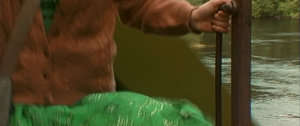
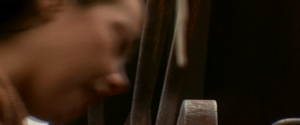
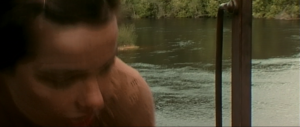
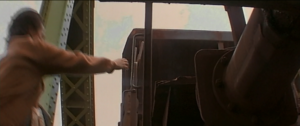
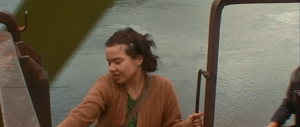
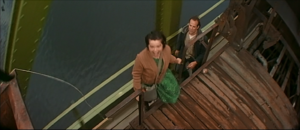
In an interview with von Trier, he said that one of the reasons they used the static cameras was so that it would not be possible to ‘stage’ the acting. They would just use what came in front of the cameras. He also said that he thought he hadn’t used enough cameras!
The only time when von Trier breaks with this contrasting style is right at the end of the film with the last musical type song. Usually, it was easy for the viewer to detect when Selma had slipped into fantasy mode because the shot style changed and the colours in the musicals was typically brighter and more colourful. However, for the last song that she sings, the style does not change but rather remains with the handheld camera style. I think this was a way of conveying to the audience that the situation is so desperate that it is not possible for Selma to fully escape into the musical mode.
Bibliography:
Dancer in the Dark [feature film, DVD] Dir. Lars von Trier. Zentropa Entertainments, Trust Films Svenska, Film Vast, Denmark, 2000. 140 min
Dancer in the Dark [documentary extra, DVD] Dir. Lars von Trier. Zentropa Entertainments, Trust Films Svenska, Film Vast, Denmark, 2000. 16 min.
